Overworld
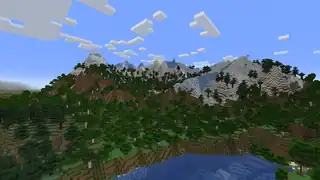
The Overworld is the primary dimension in which all players begin their Minecraft world. It is the dimension with the most biomes, blocks, and mobs, and is where most players spend the majority of their time.
Creation
The Overworld is the only dimension created when the player creates a new world. The other dimensions (The Nether and The End) aren't created until a player enters the corresponding dimension for the first time.
Seeds
A new world in Minecraft is generated through the use of a randomly generated seed, which is an integer used as a starting point for the world generation formula. The player can specify a seed or allow the game to generate one randomly. If given a non-integer input (such as the word "Glacier"), the game converts it into a corresponding integer (such as 1772835215).
A given seed generates almost exactly the same world every time, provided the same edition, game version, and world type are used. Although the exact spawn point varies, the coordinates of all terrain features are the same. All seeds within the 32-bit integer limit in Java and Bedrock editions may also generate worlds with the same terrain shape and biome map, but the placement of terrain features, structures, and carver caves may differ.
Environment
The Overworld is an incredibly complex environment with a wide variety of features.
Biomes
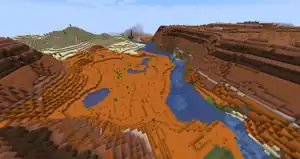
The Overworld is divided into 54 biomes of various types. A biome's type determines the basic characteristics of the terrain within it, such as the blocks composing the surface or the plants that thrive in it. The biome type also determines which mobs can spawn within it and affects how environmental behaviors such as weather are expressed within it.
Natural structures
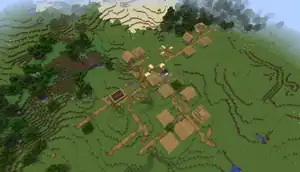
The Overworld is composed of 17 terrain patterns, called generated structures, whose arrangement varies widely from one seed to another. The exact structures are unique to each world, while the types of structures that can be generated at a given place are determined by the biome type. Structures are meant to represent real-world equivalents such as mountains, caves, and lakes. "Impossible" (in the real world) formations, such as floating islands, can also be found throughout the Overworld.
Along with terrain features, natural structures include naturally-generated buildings, such as villages, monster rooms, mineshafts, and ruined portals.
Daylight cycle
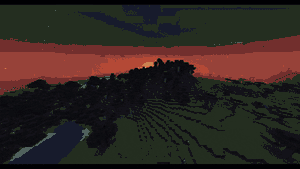
The Overworld is the only dimension with a daylight cycle and the only one where the environment reflects the passage of time. In contrast to time zones in the real world, Overworld time is universal; it is always the same time for every player in the dimension regardless of how far apart they might be, even in an "infinite" world.
During the daytime, the sun acts as a powerful light source, with a light level of 15, the maximum. Sunlight is strong enough to grow plants and affect the way mobs spawn, among other interesting effects. During the nighttime, the moon is the only natural light source. However, moonlight is comparatively dim; the light level falls to a minimum of 4, allowing hostile mobs to spawn. Other than during thunderstorms, nighttime is the only time players may sleep in a bed.
The daylight cycle can effectively be measured using a clock, which allows players to determine the approximate Minecraft time anywhere in the Overworld. Time can also be changed or stopped with the use of the /time command.
The sun rises in the east and sets in the west, just as it does in the real world, though the sun will always be directly overhead at noon. Observing its motion is a simple method of telling direction without a compass.
Mobs
The Overworld is home to 62 mobs. Mobs vary greatly in behavior and the level of danger they present to the player. Different mobs spawn at different times and places depending on the light level and the biome, among other factors. On occasion, a mob can move between the Overworld and another dimension, such as The Nether, by using a portal, but this is uncommon. Boss mobs like the ender dragon and the wither cannot enter portals.
Passive mobs
Neutral mobs
Hostile mobs
Generation
As with all other dimensions in the game, the Overworld can generate infinitely. However, there are some limitations, as detailed below. Like the other dimensions, it is divided into 16×384×16 block sections called chunks.
The Overworld encompasses a three-dimensional volume that extends vertically from the Void up to the build limit (y=-64 to 320), and horizontally for a virtually infinite distance in each direction. This volume is filled (virtually speaking) with air, terrain, and structures. Technically, the terrain is formed by generating multiple noise maps to produce differing elevations, general land shapes, and complex mountain and cave systems.
Limitations
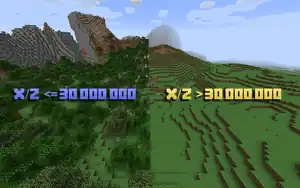
While the world is virtually infinite, the number of blocks a player may physically reach is limited with where the limits are depending on the edition of the game and the world type being played.
In Java Edition, the map contains a world border located by default at X/Z coordinates ±29,999,984. The world border is an animated wall of blue stripes. Standing near the border results in a red vignette appearing around the screen. Most entities are unable to pass the border, except by teleporting. Players who breach the border receive constant damage unless they are in Creative or Spectator mode. The player can teleport past the world border and continue as far as X/Z ±29,999,999, where there is an invisible wall. However, the player can travel a few chunks further by riding horses, pigs, minecarts and boats through it.
In Bedrock Edition, Infinite-type worlds have no fixed horizontal limits, but either generation stops or normal game behavior begins to break down at extreme distances; the exact details depend on the platform. However, experiments suggest that players can generally reach at least X/Z ±30,000,000 before many such problems occur.
Terrain features
The Overworld contains numerous terrain features, at a wide variety of scales.
Blocks
Naturally generated
"Naturally generated" includes blocks that are created through the world seed.
 Air
Air- Cave Air
- Void Air
 Bedrock
Bedrock Stone
Stone Deepslate
Deepslate Granite
Granite Diorite
Diorite Andesite
Andesite Tuff
Tuff Calcite
Calcite Dripstone Block
Dripstone Block Pointed Dripstone
Pointed Dripstone Smooth Basalt
Smooth Basalt Coal Ore
Coal Ore Deepslate Coal Ore
Deepslate Coal Ore Iron Ore
Iron Ore Deepslate Iron Ore
Deepslate Iron Ore Copper Ore
Copper Ore Deepslate Copper Ore
Deepslate Copper Ore Gold Ore
Gold Ore Deepslate Gold Ore
Deepslate Gold Ore Redstone Ore
Redstone Ore Deepslate Redstone Ore
Deepslate Redstone Ore Emerald Ore
Emerald Ore Deepslate Emerald Ore
Deepslate Emerald Ore Lapis Lazuli Ore
Lapis Lazuli Ore Deepslate Lapis Lazuli Ore
Deepslate Lapis Lazuli Ore Diamond Ore
Diamond Ore Deepslate Diamond Ore
Deepslate Diamond Ore Block of Raw Iron
Block of Raw Iron Block of Raw Copper
Block of Raw Copper Block of Amethyst
Block of Amethyst Budding Amethyst
Budding Amethyst Small Amethyst Bud
Small Amethyst Bud Medium Amethyst Bud
Medium Amethyst Bud Large Amethyst Bud
Large Amethyst Bud Amethyst Cluster
Amethyst Cluster Grass Block
Grass Block Mycelium
Mycelium Podzol
Podzol Dirt
Dirt Coarse Dirt
Coarse Dirt Rooted Dirt
Rooted Dirt Moss Block
Moss Block Moss Carpet
Moss Carpet Pale Moss Block
Pale Moss Block Pale Moss Carpet
Pale Moss Carpet Clay
Clay Mud
Mud Water
Water Lava
Lava Sand
Sand Red Sand
Red Sand Gravel
Gravel Sandstone
Sandstone Red Sandstone
Red Sandstone Snow
Snow Snow Block
Snow Block Powder Snow
Powder Snow Ice
Ice Packed Ice
Packed Ice Blue Ice
Blue Ice Oak Log
Oak Log Spruce Log
Spruce Log Birch Log
Birch Log Jungle Log
Jungle Log Acacia Log
Acacia Log Dark Oak Log
Dark Oak Log Mangrove Log
Mangrove Log Cherry Log
Cherry Log Pale Oak Log
Pale Oak Log Oak Leaves
Oak Leaves Spruce Leaves
Spruce Leaves Birch Leaves
Birch Leaves Jungle Leaves
Jungle Leaves Acacia Leaves
Acacia Leaves Dark Oak Leaves
Dark Oak Leaves Azalea Leaves
Azalea Leaves Flowering Azalea Leaves
Flowering Azalea Leaves Mangrove Leaves
Mangrove Leaves Mangrove Propagule
Mangrove Propagule Mangrove Roots
Mangrove Roots Muddy Mangrove Roots
Muddy Mangrove Roots Cherry Leaves
Cherry Leaves Pale Oak Leaves
Pale Oak Leaves Short Grass
Short Grass Tall Grass
Tall Grass Fern
Fern Large Fern
Large Fern Dead Bush
Dead Bush Dandelion
Dandelion Poppy
Poppy Blue Orchid
Blue Orchid Allium
Allium Azure Bluet
Azure Bluet Red Tulip
Red Tulip Orange Tulip
Orange Tulip White Tulip
White Tulip Pink Tulip
Pink Tulip Oxeye Daisy
Oxeye Daisy Cornflower
Cornflower Lily of the Valley
Lily of the Valley Eyeblossom
Eyeblossom Pink Petals
Pink Petals Sunflower
Sunflower Lilac
Lilac Rose Bush
Rose Bush Peony
Peony Brown Mushroom
Brown Mushroom Red Mushroom
Red Mushroom Brown Mushroom Block
Brown Mushroom Block Red Mushroom Block
Red Mushroom Block Mushroom Stem
Mushroom Stem Cactus
Cactus Sugar Cane
Sugar Cane Pumpkin
Pumpkin Melon
Melon Vines
Vines Lily Pad
Lily Pad Cocoa
Cocoa Bamboo
Bamboo Sweet Berry Bush
Sweet Berry Bush Infested Stone
Infested Stone Infested Deepslate
Infested Deepslate Terracotta
Terracotta Red Terracotta
Red Terracotta Orange Terracotta
Orange Terracotta Yellow Terracotta
Yellow Terracotta Brown Terracotta
Brown Terracotta White Terracotta
White Terracotta Light Gray Terracotta
Light Gray Terracotta Magma Block
Magma Block Kelp
Kelp Kelp Plant
Kelp Plant Seagrass
Seagrass Tall Seagrass
Tall Seagrass Sea Pickle
Sea Pickle Bubble Column
Bubble Column Tube Coral
Tube Coral Tube Coral Fan
Tube Coral Fan Tube Coral Block
Tube Coral Block Dead Tube Coral
Dead Tube Coral Dead Tube Coral Fan
Dead Tube Coral Fan Dead Tube Coral Block
Dead Tube Coral Block Brain Coral
Brain Coral Brain Coral Fan
Brain Coral Fan Brain Coral Block
Brain Coral Block Dead Brain Coral
Dead Brain Coral Dead Brain Coral Fan
Dead Brain Coral Fan Dead Brain Coral Block
Dead Brain Coral Block Bubble Coral
Bubble Coral Bubble Coral Fan
Bubble Coral Fan Bubble Coral Block
Bubble Coral Block Dead Bubble Coral
Dead Bubble Coral Dead Bubble Coral Fan
Dead Bubble Coral Fan Dead Bubble Coral Block
Dead Bubble Coral Block Fire Coral
Fire Coral Fire Coral Fan
Fire Coral Fan Fire Coral Block
Fire Coral Block Dead Fire Coral
Dead Fire Coral Dead Fire Coral Fan
Dead Fire Coral Fan Dead Fire Coral Block
Dead Fire Coral Block Horn Coral
Horn Coral Horn Coral Fan
Horn Coral Fan Horn Coral Block
Horn Coral Block Dead Horn Coral
Dead Horn Coral Dead Horn Coral Fan
Dead Horn Coral Fan Dead Horn Coral Block
Dead Horn Coral Block Bee Nest
Bee Nest Glow Lichen
Glow Lichen Cave Vines
Cave Vines Cave Vines Plant
Cave Vines Plant Azalea
Azalea Flowering Azalea
Flowering Azalea Small Dripleaf
Small Dripleaf Big Dripleaf
Big Dripleaf Big Dripleaf Stem
Big Dripleaf Stem Hanging Roots
Hanging Roots Pale Hanging Moss
Pale Hanging Moss Sculk
Sculk Sculk Sensor
Sculk Sensor Sculk Catalyst
Sculk Catalyst Sculk Shrieker
Sculk Shrieker Sculk Vein
Sculk Vein Bone Block
Bone Block Cobblestone
Cobblestone Mossy Cobblestone
Mossy Cobblestone Monster Spawner
Monster Spawner Creaking Heart
Creaking Heart Chest
Chest Suspicious Sand
Suspicious Sand Sandstone Slab
Sandstone Slab
Naturally created
"Naturally created" means a combination of events that cause a new block to be placed by natural causes, not the player. Some of these blocks may also be created as part of world generation.
Structures
These blocks are created only with the "Generate Structures" option enabled.
 Polished Granite
Polished Granite Polished Diorite
Polished Diorite Polished Andesite
Polished Andesite Polished Tuff
Polished Tuff Netherrack
Netherrack Soul Sand
Soul Sand Soul Fire
Soul Fire Oak Wood
Oak Wood Spruce Wood
Spruce Wood Acacia Wood
Acacia Wood Stripped Oak Log
Stripped Oak Log Stripped Spruce Log
Stripped Spruce Log Stripped Jungle Log
Stripped Jungle Log Stripped Acacia Log
Stripped Acacia Log Stripped Dark Oak Log
Stripped Dark Oak Log Stripped Oak Wood
Stripped Oak Wood Stripped Spruce Wood
Stripped Spruce Wood Oak Planks
Oak Planks Spruce Planks
Spruce Planks Birch Planks
Birch Planks Jungle Planks
Jungle Planks Acacia Planks
Acacia Planks Dark Oak Planks
Dark Oak Planks Acacia Sapling
Acacia Sapling Dark Oak Sapling
Dark Oak Sapling Chiseled Sandstone
Chiseled Sandstone Cut Sandstone
Cut Sandstone Smooth Stone
Smooth Stone Smooth Sandstone
Smooth Sandstone White Wool
White Wool Red Wool
Red Wool Orange Wool
Orange Wool Light Blue Wool
Light Blue Wool Yellow Wool
Yellow Wool Lime Wool
Lime Wool Gray Wool
Gray Wool Light Gray Wool
Light Gray Wool Cyan Wool
Cyan Wool Blue Wool
Blue Wool Brown Wool
Brown Wool Green Wool
Green Wool Black Wool
Black Wool White Carpet
White Carpet Orange Carpet
Orange Carpet Magenta Carpet
Magenta Carpet Gray Carpet
Gray Carpet Light Blue Carpet
Light Blue Carpet Yellow Carpet
Yellow Carpet Lime Carpet
Lime Carpet Pink Carpet
Pink Carpet Light Gray Carpet
Light Gray Carpet Cyan Carpet
Cyan Carpet Purple Carpet
Purple Carpet Blue Carpet
Blue Carpet Brown Carpet
Brown Carpet Green Carpet
Green Carpet Red Carpet
Red Carpet Black Carpet
Black Carpet Bricks
Bricks Chain
Chain Torch
Torch Lantern
Lantern Soul Lantern
Soul Lantern Candle
Candle White Candle
White Candle Brown Candle
Brown Candle Green Candle
Green Candle Purple Candle
Purple Candle Red Candle
Red Candle Block of Coal
Block of Coal Block of Copper
Block of Copper Oxidized Cut Copper
Oxidized Cut Copper Waxed Chiseled Copper
Waxed Chiseled Copper Waxed Block of Copper
Waxed Block of Copper Waxed Copper Grate
Waxed Copper Grate Waxed Cut Copper
Waxed Cut Copper Waxed Oxidized Chiseled Copper
Waxed Oxidized Chiseled Copper Waxed Oxidized Copper
Waxed Oxidized Copper Waxed Oxidized Copper Grate
Waxed Oxidized Copper Grate Waxed Oxidized Cut Copper
Waxed Oxidized Cut Copper Block of Lapis Lazuli
Block of Lapis Lazuli Block of Gold
Block of Gold Block of Diamond
Block of Diamond Crying Obsidian
Crying Obsidian Trapped Chest
Trapped Chest Furnace
Furnace Crafting Table
Crafting Table Farmland
Farmland Ladder
Ladder Bookshelf
Bookshelf Cobweb
Cobweb Melon Stem
Melon Stem Carved Pumpkin
Carved Pumpkin Jack o'Lantern
Jack o'Lantern Pumpkin Stem
Pumpkin Stem Rail
Rail Lever
Lever Stone Button
Stone Button Oak Button
Oak Button Jungle Button
Jungle Button Stone Pressure Plate
Stone Pressure Plate Oak Pressure Plate
Oak Pressure Plate Spruce Pressure Plate
Spruce Pressure Plate Acacia Pressure Plate
Acacia Pressure Plate Oak Fence
Oak Fence Spruce Fence
Spruce Fence Jungle Fence
Jungle Fence Acacia Fence
Acacia Fence Dark Oak Fence
Dark Oak Fence Oak Fence Gate
Oak Fence Gate Spruce Fence Gate
Spruce Fence Gate Jungle Fence Gate
Jungle Fence Gate Acacia Fence Gate
Acacia Fence Gate Dark Oak Fence Gate
Dark Oak Fence Gate Oak Trapdoor
Oak Trapdoor Spruce Trapdoor
Spruce Trapdoor Jungle Trapdoor
Jungle Trapdoor Acacia Trapdoor
Acacia Trapdoor Dark Oak Trapdoor
Dark Oak Trapdoor Iron Trapdoor
Iron Trapdoor Waxed Oxidized Copper Trapdoor
Waxed Oxidized Copper Trapdoor Oxidized Copper Trapdoor
Oxidized Copper Trapdoor Brick Wall
Brick Wall Cobblestone Wall
Cobblestone Wall Diorite Wall
Diorite Wall Granite Wall
Granite Wall Sandstone Wall
Sandstone Wall Cobbled Deepslate Wall
Cobbled Deepslate Wall Polished Deepslate Wall
Polished Deepslate Wall Deepslate Brick Wall
Deepslate Brick Wall Deepslate Tile Wall
Deepslate Tile Wall Iron Bars
Iron Bars Glass
Glass White Stained Glass
White Stained Glass Light Gray Stained Glass
Light Gray Stained Glass Black Stained Glass
Black Stained Glass Glass Pane
Glass Pane Brown Stained Glass Pane
Brown Stained Glass Pane White Stained Glass Pane
White Stained Glass Pane Orange Stained Glass Pane
Orange Stained Glass Pane Yellow Stained Glass Pane
Yellow Stained Glass Pane Stone Bricks
Stone Bricks Cracked Stone Bricks
Cracked Stone Bricks Mossy Stone Bricks
Mossy Stone Bricks Chiseled Stone Bricks
Chiseled Stone Bricks Infested Stone Bricks
Infested Stone Bricks Infested Mossy Stone Bricks
Infested Mossy Stone Bricks Infested Chiseled Stone Bricks
Infested Chiseled Stone Bricks Infested Cobblestone
Infested Cobblestone Cauldron
Cauldron Brewing Stand
Brewing Stand End Portal Frame
End Portal Frame End Portal
End Portal Decorated Pot
Decorated Pot Flower Pot
Flower Pot Potted Dandelion
Potted Dandelion Potted Poppy
Potted Poppy Potted Blue Orchid
Potted Blue Orchid Potted Allium
Potted Allium Potted Azure Bluet
Potted Azure Bluet Potted Red Tulip
Potted Red Tulip Potted White Tulip
Potted White Tulip Potted Oxeye Daisy
Potted Oxeye Daisy Potted Dead Bush
Potted Dead Bush Potted Spruce Sapling
Potted Spruce Sapling Potted Birch Sapling
Potted Birch Sapling Potted Red Mushroom
Potted Red Mushroom Potted Cactus
Potted Cactus Damaged Anvil
Damaged Anvil Hay Bale
Hay Bale Light Blue Terracotta
Light Blue Terracotta Lime Terracotta
Lime Terracotta Gray Terracotta
Gray Terracotta Cyan Terracotta
Cyan Terracotta Blue Terracotta
Blue Terracotta Prismarine
Prismarine Prismarine Bricks
Prismarine Bricks Dark Prismarine
Dark Prismarine Sea Lantern
Sea Lantern Wet Sponge
Wet Sponge Dirt Path
Dirt Path Ominous Wall Banner
Ominous Wall Banner Gray Wall Banner
Gray Wall Banner Light Gray Wall Banner
Light Gray Wall Banner Brown Wall Banner
Brown Wall Banner Black Wall Banner
Black Wall Banner White Glazed Terracotta
White Glazed Terracotta Orange Glazed Terracotta
Orange Glazed Terracotta Light Blue Glazed Terracotta
Light Blue Glazed Terracotta Yellow Glazed Terracotta
Yellow Glazed Terracotta Lime Glazed Terracotta
Lime Glazed Terracotta Light Gray Glazed Terracotta
Light Gray Glazed Terracotta Cyan Glazed Terracotta
Cyan Glazed Terracotta Purple Glazed Terracotta
Purple Glazed Terracotta Red Glazed Terracotta
Red Glazed Terracotta Black Glazed Terracotta
Black Glazed Terracotta Iron Door
Iron Door Waxed Copper Door
Waxed Copper Door Waxed Oxidized Copper Door
Waxed Oxidized Copper Door Oak Door
Oak Door Spruce Door
Spruce Door Jungle Door
Jungle Door Acacia Door
Acacia Door Dark Oak Door
Dark Oak Door Oak Wall Sign
Oak Wall Sign Spruce Wall Sign
Spruce Wall Sign Waxed Cut Copper Stairs
Waxed Cut Copper Stairs Waxed Oxidized Cut Copper Stairs
Waxed Oxidized Cut Copper Stairs Oak Stairs
Oak Stairs Birch Stairs
Birch Stairs Spruce Stairs
Spruce Stairs Jungle Stairs
Jungle Stairs Acacia Stairs
Acacia Stairs Dark Oak Stairs
Dark Oak Stairs Diorite Stairs
Diorite Stairs Granite Stairs
Granite Stairs Sandstone Stairs
Sandstone Stairs Smooth Sandstone Stairs
Smooth Sandstone Stairs Cobblestone Stairs
Cobblestone Stairs Mossy Cobblestone Stairs
Mossy Cobblestone Stairs Stone Brick Stairs
Stone Brick Stairs Mossy Stone Brick Stairs
Mossy Stone Brick Stairs Cobbled Deepslate Stairs
Cobbled Deepslate Stairs Polished Deepslate Stairs
Polished Deepslate Stairs Deepslate Brick Stairs
Deepslate Brick Stairs Deepslate Tile Stairs
Deepslate Tile Stairs Brick Stairs
Brick Stairs Mud Brick Stairs
Mud Brick Stairs Oak Slab
Oak Slab Spruce Slab
Spruce Slab Jungle Slab
Jungle Slab Acacia Slab
Acacia Slab Dark Oak Slab
Dark Oak Slab Stone Slab
Stone Slab Smooth Sandstone Slab
Smooth Sandstone Slab Cobblestone Slab
Cobblestone Slab Mossy Cobblestone Slab
Mossy Cobblestone Slab Smooth Stone Slab
Smooth Stone Slab Stone Brick Slab
Stone Brick Slab Polished Tuff Slab
Polished Tuff Slab Mossy Stone Brick Slab
Mossy Stone Brick Slab Cobbled Deepslate Slab
Cobbled Deepslate Slab Polished Deepslate Slab
Polished Deepslate Slab Deepslate Brick Slab
Deepslate Brick Slab Deepslate Tile Slab
Deepslate Tile Slab Brick Slab
Brick Slab Mud Brick Slab
Mud Brick Slab Waxed Cut Copper Slab
Waxed Cut Copper Slab Waxed Oxidized Cut Copper Slab
Waxed Oxidized Cut Copper Slab Tripwire Hook
Tripwire Hook Tripwire
Tripwire Redstone Dust
Redstone Dust Redstone Repeater
Redstone Repeater Redstone Comparator
Redstone Comparator Redstone Torch
Redstone Torch Block of Redstone
Block of Redstone Sticky Piston
Sticky Piston Dispenser
Dispenser Hopper
Hopper TNT
TNT Target
Target Note Block
Note Block Redstone Lamp
Redstone Lamp Waxed Copper Bulb
Waxed Copper Bulb Wheat
Wheat Carrots
Carrots Potatoes
Potatoes Beetroots
Beetroots White Bed
White Bed Brown Bed
Brown Bed Orange Bed
Orange Bed Yellow Bed
Yellow Bed Cyan Bed
Cyan Bed Purple Bed
Purple Bed Magenta Bed
Magenta Bed Blue Bed
Blue Bed Green Bed
Green Bed Red Bed
Red Bed Trial Spawner
Trial Spawner Vault
Vault Bell
Bell Loom
Loom Campfire
Campfire Barrel
Barrel Lectern
Lectern Blast Furnace
Blast Furnace Smoker
Smoker Cartography Table
Cartography Table Composter
Composter Stonecutter
Stonecutter Grindstone
Grindstone Smithing Table
Smithing Table Fletching Table
Fletching Table Skeleton Skull
Skeleton Skull Tuff Bricks
Tuff Bricks Chiseled Tuff
Chiseled Tuff Chiseled Tuff Bricks
Chiseled Tuff Bricks Cobbled Deepslate
Cobbled Deepslate Reinforced Deepslate
Reinforced Deepslate Chiseled Deepslate
Chiseled Deepslate Deepslate Bricks
Deepslate Bricks Cracked Deepslate Bricks
Cracked Deepslate Bricks Deepslate Tiles
Deepslate Tiles Cracked Deepslate Tiles
Cracked Deepslate Tiles Polished Deepslate
Polished Deepslate Polished Basalt
Polished Basalt Mud Bricks
Mud Bricks White Concrete
White Concrete Cyan Concrete
Cyan Concrete Red Concrete
Red Concrete Packed Mud
Packed Mud Suspicious Gravel
Suspicious Gravel
Technical information
ID
| Name | Identifier | Numeric ID |
|---|---|---|
overworld | 0 |
Folder
In Java Edition, information on the Overworld is stored in the region folder of the .minecraft/saves/worldname directory, with "worldname" being the name of the player's world.
Deleting the region folder resets the Overworld so that all player-made changes and buildings in that dimension are undone.
Achievements
Some achievements and advancements are obtained only in the Overworld, as their conditions cannot be replicated in the Nether or the End at all.
| Icon | Achievement | In-game description | Actual requirements (if different) | Gamerscore earned | Trophy type (PS) | ||
|---|---|---|---|---|---|---|---|
| PS4 | Other | ||||||
| Adventuring Time | Discover 17 biomes. | Visit any 17 biomes. Does not have to be in a single world. | 40 | Silver | |||
| Ahoy! | Find a shipwreck | — | 20 | Silver | |||
| Atlantis? | Find an underwater ruin | — | 20 | Silver | |||
| Echolocation | Feed a dolphin fish to have it lead you to treasure | Feed a dolphin cod or salmon and have it lure you to treasure. | 20 | Silver | |||
| Let It Go! | Using the Frost Walker boots, walk on at least 1 block on frozen water on a deep ocean | — | 20 | Bronze | |||
| Me Gold! | Dig up a buried treasure | Open a buried treasure chest. | 30 | Silver | |||
| Sail the 7 Seas | Visit all ocean biomes | Visit all ocean biomes except the deep warm ocean/legacy frozen ocean (as they are unused). | 40 | Gold | |||
| Treasure Hunter | Acquire a map from a cartographer villager, then enter the revealed structure | Visit the structure indicated while the purchased map is in your main hand (hotbar). | 40 | Silver | |||
Advancements
| Icon | Advancement | In-game description | Actual requirements (if different) |
|---|---|---|---|
 | Adventuring Time | Discover every biome | Visit all of these 54 biomes:
|
 | Eye Spy | Follow an Eye of Ender | Enter a stronghold. |
 | Feels Like Home | Take a Strider for a loooong ride on a lava lake in the Overworld | While riding a strider, travel 50 blocks on lava in the . Only horizontal displacement is counted. Traveling in a circle for more than 50 blocks doesn't count. |
 | Sound of Music | Make the Meadows come alive with the sound of music from a Jukebox | Use a music disc on a jukebox that stands within a meadow biome. |
 | Star Trader | Trade with a Villager at the build height limit | Stand on any block that is higher than 318 and trade with a villager or wandering trader. |
 | Subspace Bubble | Use the Nether to travel 7 km in the Overworld | Use the Nether to travel between 2 points in the with a minimum horizontal euclidean distance of 7000 blocks between each other, which is 875 blocks in the Nether. |
 | Surge Protector | Protect a Villager from an undesired shock without starting a fire | Be within 30 blocks of a lightning strike that doesn't set any blocks on fire, while an unharmed villager is within or up to six blocks above a 30×30×30 volume centered on the lightning strike. |
 | Sweet Dreams | Sleep in a Bed to change your respawn point | Lie down in a bed. The advancement is granted as soon as the player is in the bed, even if the player does not successfully sleep. |
 | Uneasy Alliance | Rescue a Ghast from the Nether, bring it safely home to the Overworld... and then kill it | Kill a Ghast while being in the . |
 | Very Very Frightening | Strike a Villager with lightning | Hit a villager with lightning created by a trident with the Channeling enchantment, turning it into a witch. |
History
| Java Edition pre-Classic | |||||||
|---|---|---|---|---|---|---|---|
| Cave game tech test | The map is originally finite, with randomly-generated terrain. | ||||||
| rd-132211 | The map terrain is changed to be completely flat. | ||||||
| rd-160052 | The terrain is now composed of hills and valleys. | ||||||
| Java Edition Classic | |||||||
| 0.0.12a | Terrain changed to shallow hills. | ||||||
| The Minecraft world is now surrounded by an ocean with a floor of bedrock. | |||||||
| Pressing N generates a new level. | |||||||
| August 25, 2009 | New generator showed off with terrain given more cliffs, longer and narrower caves. | ||||||
| Java Edition Indev | |||||||
| 20100212-1210 | Added the daylight cycle. | ||||||
| Java Edition Infdev | |||||||
| 20100227-1414 | First test of infinite world generation, using the same terrain generator as in Indev. | ||||||
| 20100327 | New terrain generator, removing flowers and caves temporarily. | ||||||
| Height limit increased to 128. Previously the build limit was 64 (32 blocks above sea level and 32 below). | |||||||
| 20100611 | Changed terrain generator. | ||||||
| Java Edition Alpha | |||||||
| v1.2.3 | The F3 key toggles a debug console that shows the player's exact coordinates. | ||||||
| Java Edition Beta | |||||||
| 1.3 | Players can now specify a world's name and seed. | ||||||
| 1.5 | Added weather. | ||||||
| 1.7 | An 'f' value was added to the debug console, indicating the direction the player is facing. | ||||||
| 1.8 | Pre-release | New terrain generator. | |||||
| The Far Lands were removed. | |||||||
| Java Edition | |||||||
| 1.2.1 | 12w07a | The build limit has been increased from 128 to 256. | |||||
| 1.3.2 | pre | The code of each dimension now contains the verbal name of the dimension, which is currently used only in the server console when shutting down. This is the first version in which this dimension was officially named "Overworld". | |||||
| 1.7.2 | 13w36a | Cave Generation was tweaked, making caves less dense and interconnected.[1] | |||||
| New biomes were added and some old biomes were changed. | |||||||
| 1.8 | 14w17a | Added a world border, which appears one chunk before the world boundary, and can be penetrated. | |||||
| 1.13 | 18w08a | Added the warm ocean, lukewarm ocean, cold ocean, deep lukewarm ocean, deep cold ocean, and deep frozen ocean biomes. | |||||
| Frozen oceans now generate again and have been given a new look. | |||||||
| 18w15a | Ocean variants now have their own water colors. | ||||||
| 1.18 | Experimental Snapshot 1 | Terrain now generates using the multi-noise biome source type. | |||||
| Terrain generation is now independent from biomes, with biomes adapting to whatever terrain they happen to generate throughout. | |||||||
| Terrain is now smoother and more extreme. | |||||||
| The build limit has been increased by 64 blocks above and 64 blocks below, now reaching from -64 to 320. | |||||||
| Added 3 Noise caves: Cheese, spaghetti and noodle. | |||||||
| The values C, E, T, H, and W have been added to the Debug Console under the Multinoise line, representing the biome's continentialness, erosion, temperature, humidity, and weirdness, respectively. | |||||||
| The Terrain line has been added to the Debug Console, which lists values related to terrain generation. | |||||||
| Experimental Snapshot 2 | Clouds now spawn at y=192, rather than y=128. | ||||||
| Biome generation has been tweaked. | |||||||
| Old Mountains are now labeled as Extreme Hills, and Gravelly Mountains are now Gravelly Hills. | |||||||
| Bedrock Edition | |||||||
| 1.21.60 | Preview 1.21.60.23 | The vegetation of many biomes has been updated to more closely match Java Edition. | |||||
| Legacy Console Edition | |||||||
| Xbox 360 | Xbox One | PS3 | PS4 | PS Vita | Wii U | Switch | |
| TU1 | CU1 | 1.00 | 1.00 | 1.00 | Patch 1 | 1.0.1 | Added the overworld. |
| TU12 | The build limit has been increased from 128 to 256. | ||||||
Issues
Issues relating to "Overworld" are maintained on the bug tracker. Issues should be reported and viewed there.
Gallery
Screenshots
-
 The classic finite generator used in late 2009.
The classic finite generator used in late 2009. -
 The version of the terrain generator used prior to Alpha v1.2.0.
The version of the terrain generator used prior to Alpha v1.2.0. -
 The world generator used from Alpha v1.2.0 to Beta 1.7.3.
The world generator used from Alpha v1.2.0 to Beta 1.7.3. -
 The world generator used from Java Edition Beta 1.8 to 1.6.4.
The world generator used from Java Edition Beta 1.8 to 1.6.4. -

-
 The world generator used from Java Edition 1.18.
The world generator used from Java Edition 1.18. -
 Another view of post-1.18 world generation.
Another view of post-1.18 world generation.
In other media
-
 Artwork of an island base.
Artwork of an island base. -
 Artwork for the 15th anniversary of Minecraft, showing a view of the Overworld with many mobs, including nearly every character.
Artwork for the 15th anniversary of Minecraft, showing a view of the Overworld with many mobs, including nearly every character. -
![The Overworld as it appears in Around the Minecraft World in 80 Biomes.[2]](./_assets_/37f02892686e2d829ae712e7baa481a1.jpeg) The Overworld as it appears in Around the Minecraft World in 80 Biomes.[2]
The Overworld as it appears in Around the Minecraft World in 80 Biomes.[2] -
 The Overworld as it appears in Sonic Racing: CrossWorlds.
The Overworld as it appears in Sonic Racing: CrossWorlds. -
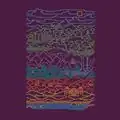 Official T-shirt "Line Time" depicting the overworld made by JINX.
Official T-shirt "Line Time" depicting the overworld made by JINX. -
 Poster of the Overworld.
Poster of the Overworld.
Trivia
- The maximum number of blocks that can be generated in the Overworld is approximately 921.6 quadrillion (9.216×1017) blocks, assuming a distance of 30,000,000 blocks in either direction.
- The total area is about 8 times the surface of the Earth.
- This means that storing a filled world, with no entities or block entities, would require 3.6864 quintillion (3.6864×1018) bits (409 petabytes) for the block data alone, based on the fact that each standard block is assigned 4 bits of information.
- By manually modifying the game, it is possible to generate the world up to 2,147,483,647 blocks (the 32-bit integer limit) in either direction.
- A 1:1 (1 block = 1 meter) scale map of the Earth, built-in Minecraft, would be 510.9 trillion (5.109×1014) blocks in size.
- Assuming the map is one block deep and uses 1 byte per block, its size would be approximately 475,800 GB (464.7 TB).
- A Moon-sized map would be made of 37.95 trillion (3.795×1013) blocks. Its data size would be 35,340 GB (34.52 TB).
See also
- Tutorials/Navigation – Tips for navigating at the Overworld
- Survival
- The Nether
- The End
References
| Geography | |||||||
|---|---|---|---|---|---|---|---|
| Sky and fog | |||||||
| Dimensions | |||||||
| World types |
| ||||||
| Player constructions |
| ||||||
| Matter | |||||||
| Sound | |||||||
| Weather | |||||||
| Joke |
| ||||||
| Removed |
| ||||||